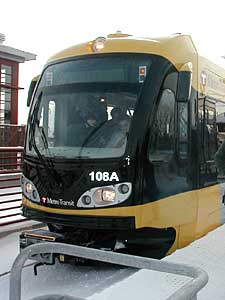|
Photos
Your Voice
|
Media mob Minneapolis light rail for free ride
January 28, 2004
 |
| Bombardier manufactured Minneapolis Hiawatha light-rail cars (MPR Photo/Dan Olson) |
Minneapolis, Minn. — A -7 temperature and a fresh-as-an-ice-cube-down-your-shirt wind greeted the media. The riders gathered at the 46th St. light rail station along Hiawatha Ave. in south Minneapolis. Most did the "Minnesota minuet," bouncing from leg to leg to keep warm, waiting for the train to pull in. Hiawatha light rail spokesman Josh Collins tried to take the edge off the chilling event by pointing out the overhead lamps.
"We do have the radiant heat here. You can press a button, and the heat will keep you somewhat warm but with the bitter chill this morning it's tough to cut through that," Collins said.
 | |||
A northwest wind breezed through the windowless platform. When finished, all above-ground stations will have transparent barriers to cut the worst of the wind chill.
Finally, the welcome headlights of downtown-bound light rail car 108 glided into view. A gush of 65-degree air greeted riders stepping into the car. The vehicles are air conditioned in summer.
There's no snowplow on the front of the light rail trains. Engineer Stu Swartz says the tracks are kept free of ice and snow by constant travel of the steel-wheeled rail cars.
"When we know we're going to get large amounts of snow, what we'll do is continue to run trains in order to keep the system open," Swartz says. "During this last snow session we just had, we did very well in running our trains. By continuous running it kept our flanges in really good shape, so it worked very well."
The trains stop for 15 seconds at each station to take on riders. Four sets of doors on each car spring open. Buzzers sound to warn riders when doors open and close before the train rolls off.
Each light rail car seats 66 people, and there room for another 180 standing passengers. Officials predict the standees won't fall over each other. Unlike herky-jerky rides on buses, which joust for space in traffic and brake heavily for stops, light rail vehicles maintain a constant speed on their own right of way and then glide to a stop at stations.
 | |||
Engineer Stu Swartz is one of the instructors teaching others how to operate the Hiawatha light rail line. Metro Transit operates the service for the Metropolitan Council. They've hired 15 people, all former bus drivers, to be light rail engineers.
Swartz says he's been a locomotive engineer for both freight and passenger trains all over the country.
"Eighteen-thousand ton coal trains out in the coal country of Wyoming. I've run 110 miles an hour out in the northeast corridor with Amtrak," Swartz says.
Driving the Hiawatha light rail cars, by contrast, will be more like a walk to the store. Top speed will be 55 mph, with much slower speeds in downtown Minneapolis.
 | |||
Still a worry is not running over pedestrians or crashing into cars. Flashing lights and screeching boxes near sidewalks warn walkers a train is coming. Long, red-and-white crossing gates drop and block car traffic when the train crosses city streets.
Hiawatha officials say driver and pedestrian behavior is shaping up nicely along the line, as residents get the hang of living with a form of transit last seen in the Twin Cities in l954.
Metro Transit manager Mike Setzer says it'll cost $16 million a year to operate the Hiawatha light rail line. One-third of the revenue will come from passenger fares. The rest will come from the state and Hennepin County.
In other North American cities with light rail service, as soon as the trains are running neighboring communities begin lobbying for service. Road building in Minnesota has a constitutionally-dedicated source of revenue from the state gas tax. Transit, Setzer says, is still reliant on the wishes of lawmakers.
"The whole subject of how to finance transit operations -- both bus and rail -- is very much up for decision-making in the Legislature in the next few years, that's the unanswered question right now."
April 3 marks the beginning of partial service along the Hiawatha light rail line, with full service set for December 2004.
|
News Headlines
|
Related Subjects
|
